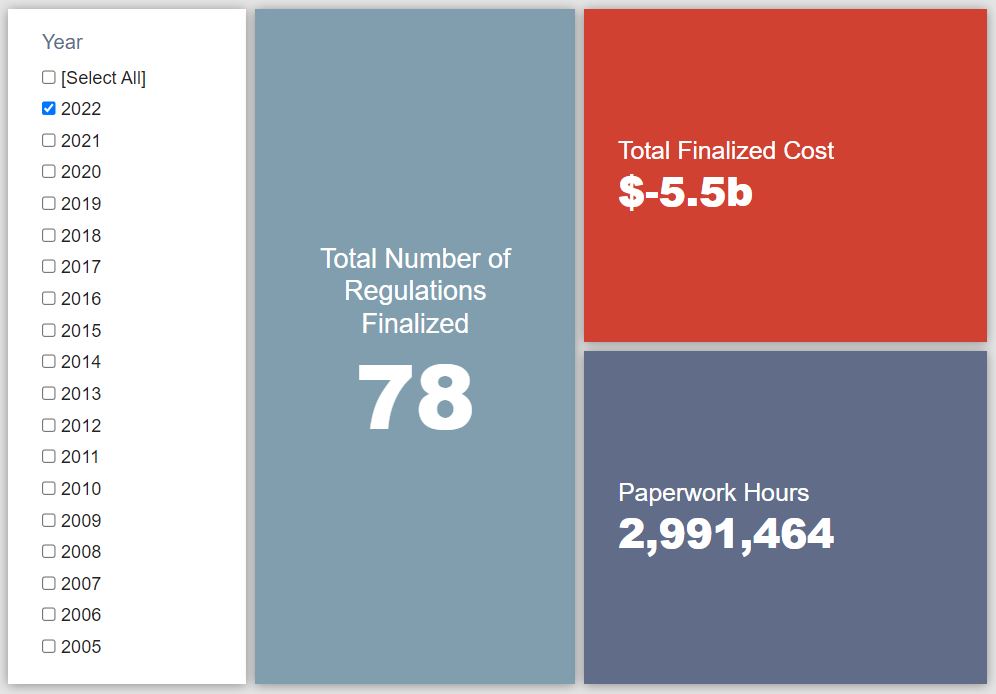Week in Regulation
April 25, 2022
A Mid-April Lull
After a relatively steady stream of weeks with economic impacts in the billions of dollars, this past week of regulatory activity seemed downright quaint. Across the 13 actions with some quantified cost or paperwork estimate, only one exceeded the $100 million threshold in terms of expected costs. The most potentially consequential measure – covered further in This Week’s Regulatory Picture, below – may have in fact come outside of those other 13 actions. Across all rulemakings, agencies published $272.9 million in total net costs and added roughly 2 million annual paperwork burden hours.
REGULATORY TOPLINES
- Proposed Rules: 31
- Final Rules: 41
- 2022 Total Pages: 24,232
- 2022 Final Rule Costs: -$5.5 billion
- 2022 Proposed Rule Costs: $68.4 billion
NOTABLE REGULATORY ACTIONS
From a quantifiable economic perspective, the most significant rulemaking of the week was a proposed rule from the Securities and Exchange Commission (SEC) entitled “Further Definition of ‘As a Part of a Regular Business’ in the Definition of Dealer and Government Securities Dealer.” The proposal’s title provides a fairly succinct summary of its purpose. More specifically, the proposed rule seeks to establish definitions that would bring certain actors under its purview that currently operate outside of the agency’s regulatory scope. Bringing these entities into the SEC fold would, of course, subject them to certain baseline reporting requirements. SEC estimates that the administrative burdens these entities would now face add up to more than 1.8 million hours of paperwork and $42 million in costs each year (or roughly $126 million total over the standard three-year window for paperwork requirements).
TRACKING THE ADMINISTRATIONS
As we have already seen from executive orders and memos, the Biden Administration will surely provide plenty of contrasts with the Trump Administration on the regulatory front. And while there is a general expectation that the new administration will seek to broadly restore Obama-esque regulatory actions, there will also be areas where it charts its own course. Since the American Action Forum (AAF) RegRodeo data extend back to 2005, it is possible to provide weekly updates on how the top-level trends of President Biden’s regulatory record track with those of his two most recent predecessors. The following table provides the cumulative totals of final rules containing some quantified economic impact from each administration through this point in their respective terms.
![]()
Given the overall lack of significant activity – especially on the final rule side – it was yet another relatively quiet week for the Biden Administration. There was, however, some notable movement from those two other administrations. The Trump Administration showed continued progress in its deregulatory efforts with $1.6 billion in cost reductions, mostly from a Department of Health and Human Services rule. On the other side of the coin, an Obama-era Department of Energy rule on efficiency standards for residential water heaters rocketed that administration’s cost total up by almost $27 billion. The Obama cost total through its first 15 months is now only $91.6 billion behind that of Biden’s total thus far.
THIS WEEK’S REGULATORY PICTURE
This week, Trump-era environmental review reforms get scrapped.

On April 20, the Council on Environmental Quality (CEQ), the agency responsible for implementing the National Environmental Policy Act (NEPA), published a final rule that reverses some of the changes made by the Trump Administration.
The final rule is virtually the same as the proposed rule (see here for more information). It restores language regarding the statement of “purpose and need” for a proposed project. The Trump rule had required this statement to be viewed primarily through the goal of the applicant. Reversing this provision would allow for greater consideration of other factors, including the public interest.
The new rule also reverses a change made by the Trump Administration that essentially set CEQ’s standards as the ceiling for an agency’s own NEPA regulations. The Biden Administration instead makes CEQ’s regulations a minimum threshold, allowing agencies to go above and beyond with their own rules.
Finally, the new rule broadens the definition of “effects” that agencies use to evaluate environmental impacts and restores the consideration of cumulative impacts, such as future emissions that may exacerbate climate change, in reviewing proposed actions. The Trump-era rule limited consideration to only immediate, foreseeable impacts.
The Trump Administration’s rule sought to address lengthy delays due to NEPA in the federal permitting process. According to a 2018 CEQ study, review times more than doubled since the 1970s and 25 percent of reviews took more than six years. By reversing the changes, approval times will likely remain on their increasing trend. The change will also lead to higher costs and unnecessary delays for one of the administration’s top priorities – projects funded through last year’s bipartisan infrastructure law.
But the Biden Administration CEQ is not yet finished. It is promising a second NEPA rule, to be proposed later this year, that will make more “comprehensive” changes to the regulations.
TOTAL BURDENS
Since January 1, the federal government has published $63 billion in total net costs (with $5.5 billion in new cost savings from finalized rules) and 47.1 million hours of net annual paperwork burden increases (with 3 million hours in increases from final rules).












